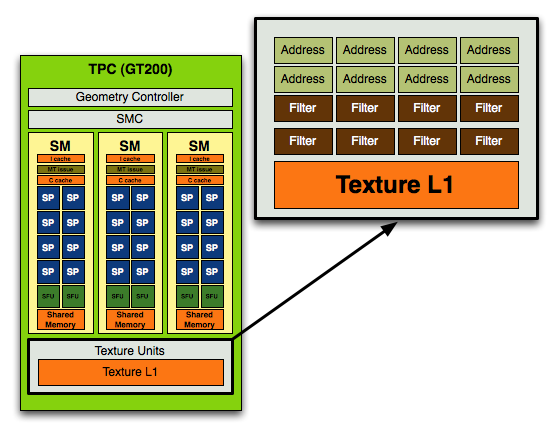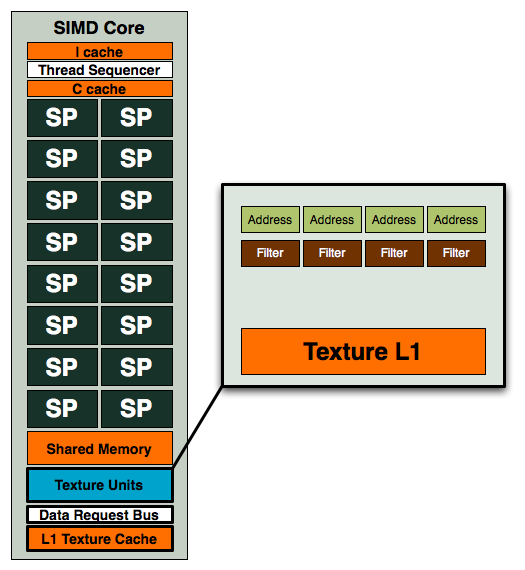The Radeon HD 4850 & 4870: AMD Wins at $199 and $299
by Anand Lal Shimpi & Derek Wilson on June 25, 2008 12:00 AM EST- Posted in
- GPUs
That Darn Compute:Texture Ratio
With its GT200 GPU, NVIDIA increased compute resources by nearly 90% but only increased texture processing by 25%, highlighting a continued trend in making GPUs even more powerful computationally. Here's another glance at the GT200's texture address and filter units:

Each TPC, of which there are 10, has eight address and eight filter units. Now let's look at RV770:

Four address and four filter units, while AMD maintains the same 1:1 address-to-filter ratio that NVIDIA does, the ratio of compute-to-texture in RV770 is significantly higher.
| AMD RV770 | AMD RV670 | NVIDIA GT200 | NVIDIA G92 | |
| # of SPs | 160 | 64 | 240 | 128 |
| Texture Address/Filter Units | 40 / 40 | 16 / 16 | 80 / 80 | 64 / 64 |
| Compute to Texture Ratio | 4:1 | 4:1 | 3:1 | 2:1 |
The table above illustrates NVIDIA's trend of increasing the compute to texture ratio from 2:1 in G92 to 3:1 in GT200. AMD arguably overshot with RV670 and its 4:1 ratio and thus didn't need to adjust it with RV770. Even while staying still at 4:1 with RV770, AMD's ratio is still more aggressively geared towards compute than NVIDIA's is. That does mean that more texture bound games will do better on NVIDIA hardware (at least proportionally), while more compute intensive games may do better on RV770.
AMD did also make some enhancements to their texture units as well. By doing some "stuff" that they won't tell us about, they improved the performance per mm^2 by 70%. Texture cache bandwidth has also been doubled to 480 GB/s while bandwidth between each L1 cache and L2 memory is 384 GB/s. L2 caches are aligned with memory channels of which there are four interleaved channels (resulting in 8 L2 caches).
Now that texture units are linked to both specific SIMD cores and individual L1 texture caches, we have an increase in total texturing ability due to the increase in SIMD cores with RV770. This gives us a 2.5x increase in the number of 8-bit per component textures we can fetch and bilinearly filter per clock, but only a 1.25x increase in the number of fp16 textures (as fp16 runs at half rate and fp32 runs at one quarter rate). It was our understanding that fp16 textures could run at full speed on R600, so the 1.25x increase in performance for half rate texturing of fp16 data makes sense.
Even though fp32 runs at quarter rate, with the types of texture fetches we would need to do, AMD says that we could end up being external memory bandwidth bound before we are texture filtering hardware bound. If this is the case, then the design decision to decrease rates for higher bit-depth textures makes sense.
| AMD RV770 | AMD RV670 | |
| L1 Texture Cache | 10 x 16KB (160KB total) | 32KB |
| L2 Texture Cache | I can has cache size? | 256KB |
| Vertex Cache | ? | 32KB |
| Local Data Share | 16KB | None |
| Global Data Share | 16KB | ? |
Even though AMD wouldn't tell us L1 cache sizes, we had enough info left over from the R600 time frame to combine with some hints and extract the data. We have determined that RV770 has 10 distinct 16k caches. This is as opposed to the single shared 32k L1 cache on R600 and gives us a total of 160k of L1 cache. We know R600's L2 cache was 256k, and AMD told us RV770 has a larger L2 cache, but they wouldn't give us any hints to help out.










215 Comments
View All Comments
shadowteam - Wednesday, June 25, 2008 - link
Did you know these chips can do up to 125C? 90C is so common for ATI cards, I haven't had one since 2005 that didn't blow me hair dry. Your NV card was just a bad chip I suppose. Why do you think NV or ATI would spend a billion dollars in research work, then let its product burn away due to some crappy cooling? They won't give you more cooling than you actually need. It's the same very cards that go to places like Abu-Dhabi, where room temps. easily hit 50C+.soloman02 - Wednesday, June 25, 2008 - link
Sorry, but no human would survive a temp of 50C.http://en.wikipedia.org/wiki/Thermoregulation#Hot">http://en.wikipedia.org/wiki/Thermoregulation#Hot
In fact the highest temp a human has survived was recorded by the Guinness book of world records as: 46.5C (115.7F). Keep in mind that was the internal temp of the guy. The temp on that day was 32.2C (90F).
http://www.powells.com/biblio?show=0553587129&...">http://www.powells.com/biblio?show=0553587129&...
http://www.time.com/time/magazine/article/0,9171,9...">http://www.time.com/time/magazine/article/0,9171,9...
If it is 50C in those rooms, the people inside are dead or dying.
The cards are probably fine. All it takes is to search google to back up your figures (or to disprove them like I just did).
shadowteam - Wednesday, June 25, 2008 - link
You're just a dumb pissed off loser. There's a big difference in internal human temperature to its surroundings. In places like Sahara, temperatures routinely hit 45C, and max out @ 55C. But does that mean people living there just die? No they don't, because they drink a lot of water, which helps their bodies get rid of excess heat so to keep their internals at normal temperature (32C). You didn't have this knowledge to share so you decided to Google it instead, and make fool out of yourself. Here, let me break it down for you,You said: "Keep in mind that was the internal temp of the guy"
Exactly, the guy was sick, and when you're sick, your body temperature rises, in which case 46C is the limit of survival. I suggest you take Bio-chemistry in college to learn more about human body, which is another 4 years before you finish school.
Ilmarin - Wednesday, June 25, 2008 - link
I'm not talking about chips failing altogether... just stability issues, similar to what you experience from over-zealous overclocking. Lots of people have encountered artifacting/crashes with stock-cooled cards over the years. If these are just 'bad chips' that are experiencing stability issues at high temps, then there are a lot of them getting through quality control. Of course NV and ATI do enough to make most people happy... but many of us have good reason to be nervous about temperature. I think they can and should do better. Dual slot exhaust coolers should be mandatory for the enthusiast/performance cards, with full fan control capability. Often it's up to the partners to get that right, and often it doesn't happen for at least a couple of months.shadowteam - Wednesday, June 25, 2008 - link
I think it's more profitable for board partners to just roll out a stock card rather than go through the trouble of investing time/money into performance cooling. What I've seen thus far, and it's quite apparent, that newer companies tend to go exotic cooling to get themselves heard. Once they're in the game, it's back to stock cooling. For example, Palit and ECS came up with nice coolers for its 9600s. Remember Leadtek from past years? They don't even do custom coolers any more. ASUS, Powercolor, Gigabyte, Sapphire etc just find it easier to throw in a 3rd party cooler from ZM, TT TR, and call it a day.DerekWilson - Wednesday, June 25, 2008 - link
you know we actually received an updated bios for a certain vendors 4850 that speeds the fan up a bit and should reduce heat ...i suspect a lot of vendors will start adjusting their fan tables actually ...
shadowteam - Wednesday, June 25, 2008 - link
I think this reply was meant for the guy right above me. I'm all for stock cooling :).ImmortalZ - Wednesday, June 25, 2008 - link
"Quake Wars once again shows the 4870 outperforming the GTX 280, but this time it offers essentially the same performance as the GTX 280 - but at half the price. "You mean the 260 in the first instance?
No text in The Witcher page. I assume this is intentional.
Also, I've heard on the web that the 48xx series has dual-link only on one of it's DVI ports. Is this true?
Oh and another thing - why is the post comment page titled "Untitled Page"? :P
rahat5810 - Wednesday, June 25, 2008 - link
Nice cards and nice article. But I would like to point out that there are some mistakes in the article, nothing fatal though. Like, not mentioning 4870 in the list of cards, writing 280 instead of 260, clicking on the picture to enlarge not working for some of the figures.feelingshorter - Wednesday, June 25, 2008 - link
AMD almost has a perfect card but the fact that the 4870 idles at 46.1 more watts than the 260 means the card will heat up people's room. At load, the difference of 16.1 watts more for the 4870 is forgivable.If its possible to overclock a card using software (without going into BIOS screen), then why isn't it possible to underclock a card also using software when the card's full potential isn't being used? I'd really be interested in knowing the answer, or maybe someone just hasn't asked the question?
I hardly care about Crysis, its more a matter of will it run Starcraft II with 600 units on the map without overheating. Why doesn't anandtech also test how hot the 4870 runs? Although the 4850 numbers aren't pretty at all, the 4870 is a dual slot cooler and might give better numbers right? I only want to know because, like a lot of readers, i have doubts as to whether a card like the 4850 can run super hot and not die within 1+ years of hardcore gaming.